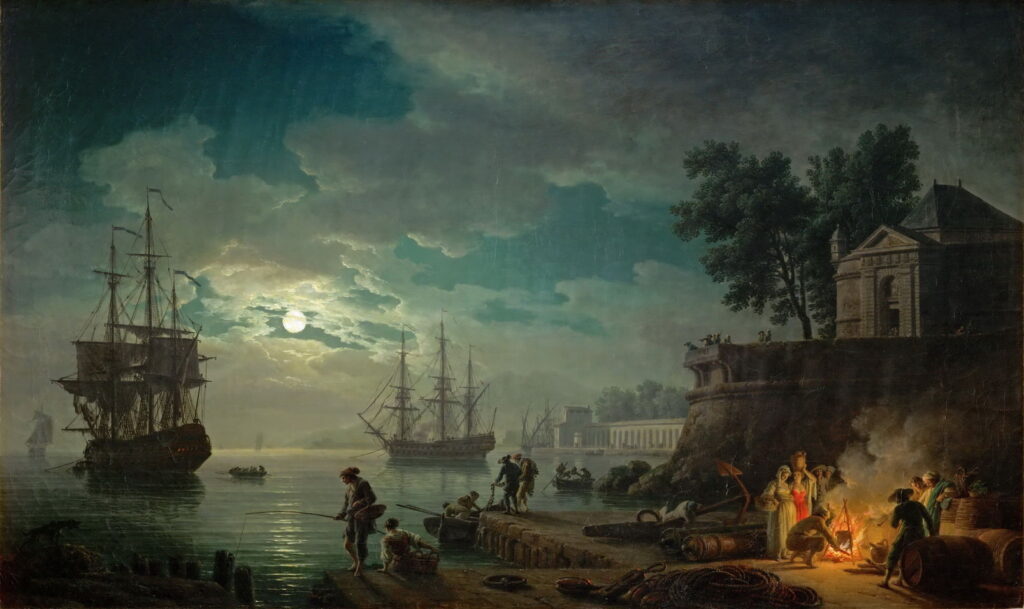Sea of Mists: Influences on Caspar David Friedrich and Romantics

German Romantic painting has never been particularly popular or well-known outside Germany, although the enigmatic works of its leading exponent, Caspar David Friedrich, have been rediscovered from time to time. Compared with the writers and composers of the movement, even Friedrich is little-known. This series of articles looks at the paintings of Friedrich, his contemporaries and followers, whose distinctive images were created between about 1800 and 1880.
Caspar David Friedrich (1774–1840), Wanderer above the Sea of Mists (1818), oil on canvas, 94.8 × 74.8 cm, Kunsthalle Hamburg. Wikimedia Commons.
Friedrich’s famous Wanderer above the Sea of Mists from 1818 uses extensive mist and cloud both to detach its scenery from ground level, and to maintain a pervasive air of mystery. A bareheaded, blond man stands with his back to the viewer (a device known as Rückenfigur) astride a rocky outcrop in the Elbe Sandstone Mountains, a walking stick in his right hand. He looks out over a blanket of lower cloud, pierced by occasional rock pinnacles and peaks.
Carl Gustav Carus (1789–1869), View of Dresden at Sunset (c 1822), oil on canvas, 22 x 30.5 cm, Kunstsammlungen Chemnitz, Chemnitz, Germany. Wikimedia Commons.
Carl Gustav Carus was a close friend and pupil of Friedrich who was also a distinguished polymath. One of his finest painting is this View of Dresden at Sunset from about 1822. The famous spires and towers of the city are seen against the rich, warm light of dusk. Sat admiring the sight are the backs of two figures, one wearing a distinctive top hat.
Carl Friedrich Lessing (1808–1880), The Return of the Crusader (1835), oil on canvas, 66 × 64 cm, LVR-LandesMuseum Bonn, Rheinisches Landesmuseum für Archäologie, Kunst- und Kulturgeschichte, Bonn, Germany. Wikimedia Commons.
Carl Friedrich Lessing was a follower of Friedrich who became a leading figure in the Düsseldorf school of landscape painting. The crusades presented him with an ideal combination of mediaeval history, romance, and chivalry. In The Return of the Crusader from 1835, he shows a lone knight in full armour dozing as his horse plods its way up a path from the coast, after a Romantic poem by the German writer Karl Leberecht Immermann (1796-1840).
Friedrich and his followers were influenced by several painters of the eighteenth century, including Claude-Joseph Vernet (1714–1789), Caspar Wolf (1735–1783), Philip James de Loutherbourg (1740-1812), and Henry Fuseli (1741–1825).
Claude-Joseph Vernet
The senior member of a family of French painters, he was a prolific landscape and marine artist who spent much of his career in Rome.
Claude-Joseph Vernet (1714–1789), The Four Times of Day: Night (1757), oil on silvered copper, 29.5 x 43.5 cm, Art Gallery of South Australia, Adelaide, Australia. Wikimedia Commons.
In Night, one of his Four Times of Day from 1757, Vernet takes us down to the coast, where a group who are apparently living rough on the beach are heating a large pot on an open fire. Behind them is a lighthouse, with a full moon low in the sky. A fully-rigged ship is heading into the shore, under full sail to catch what it can of the light breeze.
Claude Joseph Vernet (1714–1789), A Storm on a Mediterranean Coast (1767), oil on canvas, 113 × 145.7 cm, J. Paul Getty Museum, Los Angeles, CA. Wikimedia Commons.
Vernet’s Storm on a Mediterranean Coast from a decade later combines a wrecking with keenly-observed signs of the weather, including the coincidence of reflected and oncoming waves just off its small beach, and the trees at the upper left.
Claude-Joseph Vernet (1714–1789), Seaport by Moonlight (c 1771), oil on canvas, 98 x 164 cm, Musée du Louvre, Paris. Wikimedia Commons.
Late in his career, Vernet painted a series showing a Mediterranean port at various times of day and weather conditions, including this Seaport by Moonlight (c 1771), again featuring fully-rigged ships in low light.
Caspar Wolf
He was a pioneering Swiss landscape artist who specialised in painting views of the Alps.
Caspar Wolf (1735–1783), Thunder and Lighting on the Lower Grindelwald Glacier (c 1774-75), oil on canvas, 82 x 54 cm, Aargauer Kunsthaus, Aarau, Switzerland. Wikimedia Commons.
Caspar Wolf was one of the first landscape painters to faithfully depict mountains and glaciers in the Alps. He painted this Romantic nocturne of Thunder and Lighting on the Lower Grindelwald Glacier in his studio probably between 1774-75. I apologise for the scanning artefact in this image.
Caspar Wolf (1735–1783), Devil’s Bridge (1777), further details not known. Wikimedia Commons.
One of Wolf’s most popular paintings was this view of the Devil’s Bridge in the Saint Gothard Pass, from 1777. This shows the bridge across the Schöllenen Gorge that had only recently been widened sufficiently to allow the passage of carriages.
Caspar Wolf (1735–1783), Schloss Neu Bechburg at Önsingen (1778), oil on canvas, 63.5 x 81.5 cm, Private collection. Wikimedia Commons.
Wolf’s view of Schloss Neu Bechburg at Önsingen (1778) shows a castle built in about 1250 in the foothills of the Jura massif in central northern Switzerland.
Philip James de Loutherbourg
He was born and trained in France, where he came to specialise in dramatic landscapes and marines, before moving to London, where he was elected a member of the Royal Academy.
Philip James de Loutherbourg (1740-1812), An Avalanche in the Alps (1803), oil on canvas, 109.9 x 160 cm, Musée des Beaux-Arts de Strasbourg (loan from Tate Gallery, London). Wikimedia Commons.
Although now better known for his views of the industrial revolution in England, de Loutherbourg’s An Avalanche in the Alps (1803) shows the worst nightmare of many who crossed the Alps. A huge torrent of ice and rock boulders is still passing diagonally across the painting at the instant shown. This has swept away a wooden bridge, fragments of which are seen engulfed in ice. Three people are on the undamaged section of road; each is posed to add to the dramatic effect, one clearly praying to the heavens.
Henry Fuseli
Born as Johann Heinrich Füssli in Zürich, Switzerland, he first visited England in 1765, then lived in Italy until he returned to London, where he settled and was elected to the Royal Academy, serving as its Professor of Painting from 1799.
Henry Fuseli (1741–1825), The Nightmare (1781), oil on canvas, 101.6 × 127 cm, Detroit Institute of Arts, Detroit, MI. Wikimedia Commons.
Fuseli’s The Nightmare of 1781 remains the work by which he’s best known. Its devil is a daemonic incubus squatting on the torso of the young woman experiencing the nightmare. Lurking in the darkness to the left is the head of a black horse, whose eyes appear unseeing. The incubus stares directly at the viewer in a discomforting manner.
Henry Fuseli (1741–1825), Tiresias Appears to Ulysses During the Sacrifice (1780-85), watercolor and tempera on cardboard, 91.4 × 62.8 cm, Albertina, Vienna, Austria. Wikimedia Commons.
Fuseli was a prolific painter of literary narrative. His Tiresias Appears to Ulysses During the Sacrifice from 1780-85 is perhaps the only painting that shows Odysseus summoning the ghost of the blind seer Tiresias, after he had spent a year with Circe.
Henry Fuseli (1741–1825), The Shepherd’s Dream, from ‘Paradise Lost’ (1793), oil on canvas, 154.3 x 215.3 cm, The Tate Gallery (Purchased 1966), London. © The Tate Gallery and Photographic Rights © Tate (2016), CC-BY-NC-ND 3.0 (Unported), http://www.tate.org.uk/art/artworks/fuseli-the-shepherds-dream-from-paradise-lost-t00876
Another fine example of Fuseli’s dramatic paintings is The Shepherd’s Dream from 1793, telling a story of fairy elves bewitching a peasant, from John Milton’s Paradise Lost (1667).
These are the artists who most influenced Caspar David Friedrich, his contemporaries and followers.

